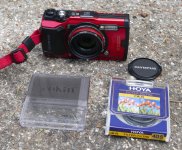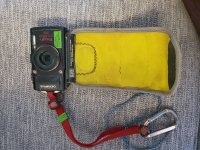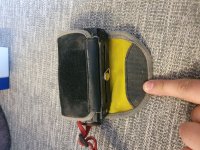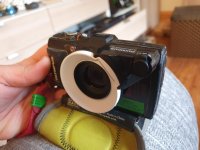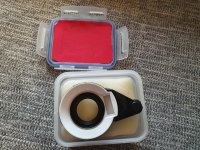ZombieCake
Well-known member
The Olympus TG series of cameras can add a variety of adaptors over the front lens for macro flashes, lens converters, etc. One of the issues with these sorts of cameras is that the lens is exposed to possible damage (whether real or imagined) as there is no built in cover. Olympus make a rotating lens barrier, the LB-T01, for about ?35. Pricey, but would solve the issue. However, they also make a converter adaptor, the CLA-T01 for around ?20. This is to allow attachment of add-on fisheye and telephoto lenses. It also comes with a clip on lens cap (which somewhat annoyingly isn't shown in the adverts). The filter thread on it is 40.5mm, which is a standard filter size. I've seen some articles suggesting it's 45mm which is very much non-standard and incorrect.
So, I decided to go for the CLA-T01. In order to protect the lens further I added a Hoya Fusion One UV filter. This has finger print repellant coatings and good optical quality. While I was at it, a circular polariser also found its way into the shopping basket, and would be an easy swap over (it'll also give you a couple of stops as an ND filter).
You could also use the square filter systems, such as the Cokin A size (67mm wide), or the Lee Seven5, via the appropriate adaptor. I'd guess that full (as opposed to graduated) neutral density (ND) filters might be the most useful. Given the lens is fairly small in diameter a soft ND grad probably wouldn't work very well, a hard ND grad might ? I'll have to experiment. (The hard and soft is the transition between the dark part of the filter and the clear part. Soft is gradual, good for landscapes. Hard is very abrupt, good for seascapes. They both help balance exposure between land and sky). I suppose a diffuser or movie mist might work as well if that's your thing. Whether all that's kind of defeating the object of a rugged point and shoot camera is another thing!
One other thing I suppose you could add would be a screw on rubber lens hood to reduce glare.
The main disadvantage to the CLA-T01 and UV filter combo is that is does add a bit of extra depth to the camera, as opposed to the LB-T01 which is quite low profile.
The photo below shows what it looks like with some filters for comparison. Thoughts and comments welcome.
So, I decided to go for the CLA-T01. In order to protect the lens further I added a Hoya Fusion One UV filter. This has finger print repellant coatings and good optical quality. While I was at it, a circular polariser also found its way into the shopping basket, and would be an easy swap over (it'll also give you a couple of stops as an ND filter).
You could also use the square filter systems, such as the Cokin A size (67mm wide), or the Lee Seven5, via the appropriate adaptor. I'd guess that full (as opposed to graduated) neutral density (ND) filters might be the most useful. Given the lens is fairly small in diameter a soft ND grad probably wouldn't work very well, a hard ND grad might ? I'll have to experiment. (The hard and soft is the transition between the dark part of the filter and the clear part. Soft is gradual, good for landscapes. Hard is very abrupt, good for seascapes. They both help balance exposure between land and sky). I suppose a diffuser or movie mist might work as well if that's your thing. Whether all that's kind of defeating the object of a rugged point and shoot camera is another thing!
One other thing I suppose you could add would be a screw on rubber lens hood to reduce glare.
The main disadvantage to the CLA-T01 and UV filter combo is that is does add a bit of extra depth to the camera, as opposed to the LB-T01 which is quite low profile.
The photo below shows what it looks like with some filters for comparison. Thoughts and comments welcome.



